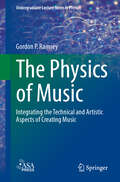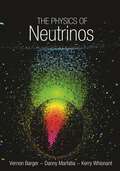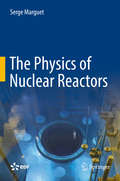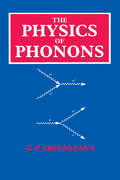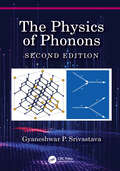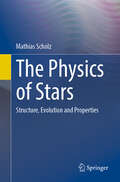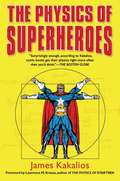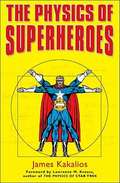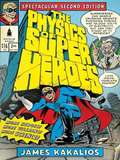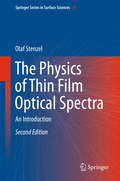- Table View
- List View
The Physics of Miracles: Tapping in to the Field of Consciousness Potential
by Richard BartlettWhen Richard Bartlett first experienced the origins of his Matrix Energetics program, his goal was only to help the patients who brought their myriad health problems to his Chiropractic practice. Now, nearly ten years after the event that would redirect the entire course of his life, Dr. Bartlett brings the power of his seminars into the book, The Physics of Miracles. By lightly touching his clients while at the same time applying focused intent, he could restore them to a physically, mentally, and spiritually balanced state, instantly shifting misalignments that had plagued them for years. Most astonishing of all, he could teach anyone how to do this. Now, for millions of people looking for empowerment in an age of declining and impersonal healthcare, Dr. Bartlett shares this phenomenon in a book full of explosive potential. In The Physics of Miracles, Dr. Bartlett builds upon his popular seminars to teach us how to access the discovery he has made--a process that merges the science of subtle energy with our innate imaginations to produce measurable results. By applying forces known to modern physics, each of us can tap into states of healthy awareness from different moments--in essence, travel in time--and bring them into the present for immediate, profound results. As Dr. Bartlett clearly shows, this practice requires no special training, produces transformation in the blink of an eye, and is available to everyone who has a willingness to learn. The Physics of Miracles provides an easily-reproducible, results-oriented process of change that draws on the fundamental principles embraced by the field of quantum and scalar physics. This paradigm-busting book can teach anyone how to access their creative power to heal and transform their lives.
The Physics of Music and Color
by Leon GuntherThe Physics of Music and Color deals with two subjects, music and color - sound and light in the physically objective sense - in a single volume. The basic underlying physical principles of the two subjects overlap greatly: both music and color are manifestations of wave phenomena, and commonalities exist as to the production, transmission, and detection of sound and light. This book aids readers in studying both subjects, which involve nearly the entire gamut of the fundamental laws of classical as well as modern physics. Where traditional introductory physics and courses are styled so that the basic principles are introduced first and are then applied wherever possible, this book is based on a motivational approach: it introduces a subject by demonstrating a set of related phenomena, challenging readers by calling for a physical basis for what is observed. The Physics of Music and Color is written at level suitable for college students without any scientific background, requiring only simple algebra and a passing familiarity with trigonometry. It contains numerous problems at the end of each chapter that help the reader to fully grasp the subject.
The Physics of Music and Color: Sound and Light
by Leon GuntherThis undergraduate textbook aids readers in studying music and color, which involve nearly the entire gamut of the fundamental laws of classical as well as atomic physics. The objective bases for these two subjects are, respectively, sound and light. Their corresponding underlying physical principles overlap greatly: Both music and color are manifestations of wave phenomena. As a result, commonalities exist as to the production, transmission, and detection of sound and light. Whereas traditional introductory physics textbooks are styled so that the basic principles are introduced first and are then applied, this book is based on a motivational approach: It introduces a subject with a set of related phenomena, challenging readers by calling for a physical basis for what is observed. A novel topic in the first edition and this second edition is a non-mathematical study of electric and magnetic fields and how they provide the basis for the propagation of electromagnetic waves, of light in particular. The book provides details for the calculation of color coordinates and luminosity from the spectral intensity of a beam of light as well as the relationship between these coordinates and the color coordinates of a color monitor. The second edition contains corrections to the first edition, the addition of more than ten new topics, new color figures, as well as more than forty new sample problems and end-of-chapter problems. The most notable additional topics are: the identification of two distinct spectral intensities and how they are related, beats in the sound from a Tibetan bell, AM and FM radio, the spectrogram, the short-time Fourier transform and its relation to the perception of a changing pitch, a detailed analysis of the transmittance of polarized light by a Polaroid sheet, brightness and luminosity, and the mysterious behavior of the photon.The Physics of Music and Color is written at a level suitable for college students without any scientific background, requiring only simple algebra and a passing familiarity with trigonometry. The numerous problems at the end of each chapter help the reader to fully grasp the subject.
The Physics of Music: Integrating the Technical and Artistic Aspects of Creating Music (Undergraduate Lecture Notes in Physics)
by Gordon P. RamseyThis textbook is designed to help students and professionals understand the intimate connection between music and physics. The reader does not need prior background in music or physics, as the concepts necessary for understanding this connection are developed from scratch, using nothing more sophisticated than basic algebra which is reviewed for the reader. The focus is on connecting physics to the creation of music and its effect on humans. The reader will learn about the basic structure of music in relation to acoustics concepts, different musical instrument groups, how the room affects sound, and how sound travels from instruments to human ears to evoke an emotional reaction. Replete with exercises to hone students’ understanding, this book is ideal for a course on the physics of music and will appeal to STEM students as well as students, professionals, and enthusiasts in any field related to music and sound engineering.
The Physics of Nascar®
by Diandra Leslie-PeleckyA physicist explores the science of speed racing With 75 million fans, NASCAR is the #1 spectator sport in America. Now, in The Physics of NASCAR, a scientist explains the intricate and complex way the sport works, in terms that anyone who drives a car?or maybe occasionally looks under the hood?can easily comprehend. Based on her extensive access to NASCAR race shops, drivers, crew chiefs, engine builders, and pit crews during races, Diandra Leslie-Pelecky traces the life cycle of a race car from its creation at top race shops to competing in the door-todoor action of the NASCAR Sprint Cup Series. .
The Physics of Neutrinos
by Kerry Whisnant Vernon Barger Danny MarfatiaThe physics of neutrinos--uncharged elementary particles that are key to helping us better understand the nature of our universe--is one of the most exciting frontiers of modern science. This book provides a comprehensive overview of neutrino physics today and explores promising new avenues of inquiry that could lead to future breakthroughs. The Physics of Neutrinos begins with a concise history of the field and a tutorial on the fundamental properties of neutrinos, and goes on to discuss how the three neutrino types interchange identities as they propagate from their sources to detectors. The book shows how studies of neutrinos produced by such phenomena as cosmic rays in the atmosphere and nuclear reactions in the solar interior provide striking evidence that neutrinos have mass, and it traces our astounding progress in deciphering the baffling experimental findings involving neutrinos. The discovery of neutrino mass offers the first indication of a new kind of physics that goes beyond the Standard Model of elementary particles, and this book considers the unanticipated patterns in the masses and mixings of neutrinos in the framework of proposed new theoretical models. The Physics of Neutrinos maps out the ambitious future facilities and experiments that will advance our knowledge of neutrinos, and explains why the way forward in solving the outstanding questions in neutrino science will require the collective efforts of particle physics, nuclear physics, astrophysics, and cosmology.
The Physics of Nuclear Reactors
by Serge MarguetThis comprehensive volume offers readers a progressive and highly detailed introduction to the complex behavior of neutrons in general, and in the context of nuclear power generation. A compendium and handbook for nuclear engineers, a source of teaching material for academic lecturers as well as a graduate text for advanced students and other non-experts wishing to enter this field, it is based on the author’s teaching and research experience and his recognized expertise in nuclear safety.After recapping a number of points in nuclear physics, placing the theoretical notions in their historical context, the book successively reveals the latest quantitative theories concerning:• The slowing-down of neutrons in matter• The charged particles and electromagnetic rays• The calculation scheme, especially the simplification hypothesis• The concept of criticality based on chain reactions• The theory of homogeneous and heterogeneous reactors• The problem of self-shielding• The theory of the nuclear reflector, a subject largely ignored in literature• The computational methods in transport and diffusion theories Complemented by more than 400 bibliographical references, some of which are commented and annotated, and augmented by an appendix on the history of reactor physics at EDF (Electricité De France), this book is the most comprehensive and up-to-date introduction to and reference resource in neutronics and reactor theory.
The Physics of Phonons
by G.P SrivastavaThere have been few books devoted to the study of phonons, a major area of condensed matter physics. The Physics of Phonons is a comprehensive theoretical discussion of the most important topics, including some topics not previously presented in book form. Although primarily theoretical in approach, the author refers to experimental results wherever possible, ensuring an ideal book for both experimental and theoretical researchers. The author begins with an introduction to crystal symmetry and continues with a discussion of lattice dynamics in the harmonic approximation, including the traditional phenomenological approach and the more recent ab initio approach, detailed for the first time in this book. A discussion of anharmonicity is followed by the theory of lattice thermal conductivity, presented at a level far beyond that available in any other book. The chapter on phonon interactions is likewise more comprehensive than any similar discussion elsewhere. The sections on phonons in superlattices, impure and mixed crystals, quasicrystals, phonon spectroscopy, Kapitza resistance, and quantum evaporation also contain material appearing in book form for the first time. The book is complemented by numerous diagrams that aid understanding and is comprehensively referenced for further study. With its unprecedented wide coverage of the field, The Physics of Phonons will be indispensable to all postgraduates, advanced undergraduates, and researchers working on condensed matter physics.
The Physics of Phonons
by Gyaneshwar P. SrivastavaThis fully updated second edition of The Physics of Phonons remains the most comprehensive theoretical discussion devoted to the study of phonons, a major area of condensed matter physics. It contains exciting new sections on phonon-related properties of solid surfaces, atomically thin materials (such as graphene and monolayer transition metal chalcogenides), in addition to nano- structures and nanocomposites, thermoelectric nanomaterials, and topological nanomaterials, with an entirely new chapter dedicated to topological nanophononics and chiralphononics. Although primarily theoretical in approach, the author refers to experimental results wherever possible, ensuring an ideal book for both experimental and theoretical researchers. The author begins with an introduction to crystal symmetry and continues with a discussion of lattice dynamics in the harmonic approximation, including the traditional phenomenological approach and the more recent ab initio approach, detailed for the first time in this book. A discussion of anharmonicity is followed by the theory of lattice thermal conductivity, presented at a level far beyond that available in any other book. The chapter on phonon interactions is likewise more comprehensive than any similar discussion elsewhere. The sections on phonons in superlattices, impure and mixed crystals, quasicrystals, phonon spectroscopy, Kapitza resistance, and quantum evaporation also contain material appearing in book form for the first time. The book is complemented by numerous diagrams that aid understanding and is comprehensively referenced for further study. With its unprecedented wide coverage of the field, The Physics of Phonons is an indispensable guide for advanced undergraduates, postgraduates, and researchers working in condensed matter physics and materials science. Features Fully updated throughout, with exciting new coverage on graphene, nanostructures and nanocomposites, thermoelectric nanomaterials, and topological nanomaterials. Authored by an authority on phonons. Interdisciplinary, with broad applications through condensed matter physics, nanoscience, and materials science. --
The Physics of Planet Earth and Its Natural Wonders
by Dmitry LivanovFrom earthquakes to the northern lights and tsunamis to glacier movement, the author explains thousands of phenomena in the world around us. All of this is done using language that is simple and understandable, and at the same time this book does not try to deceive the reader, as materials of this nature often do, but uses exact physical formulas where they are needed.This book serves as an invaluable reference for physics teachers and should inspire high school students to study physics. Many of them will very likely be able to understand that riveting events and phenomena lie behind those very same formulas that just yesterday seemed so boring.This is an excellent and unique way of easily submerging oneself into the world of science and a non-stop intellectual challenge that lures the reader in much more than any game of chess.Sir Andre Geim, 2010 Nobel Prize Laureate in PhysicsThere are plenty of high school students who continue to find science interesting today. Dmitry Livanov’s book, which is both useful and held in high regard, is written precisely with these young people in mind.This book can be used by teachers who want to expand the narrow scope of subject material in their classes and enable students to broaden their perspective about how to apply the laws of physics in order to understand such a complex natural object as planet Earth. This book will be of interest to high school students and graduates of high schools, specialized high schools and preparatory schools who want to test their understanding of physics, astronomy and geography. This book strengthens the foundation of scientific knowledge in today’s world, which repeatedly tests the strength of the collective body of science.Evgeniy Yamburg,Member of the Russian Academy of EducationPrincipal, School #109, Moscow Dmitry Livanov was able to write a book that is interesting both for those who are just beginning to become familiar with physics, and for those who for various reasons have forgotten much of what they knew at one time. He succeeded in doing this because he himself knows and loves physics and because physics—as the most important part of human culture—is interesting to him.I hope that readers of this book will not only recognize the usefulness and importance of physics, but also appreciate its beauty and allure.Andrey Furchenko,Doctor of Physics and Mathematics,Aide to the President of the Russian Federation
The Physics of Polarized Targets
by Tapio O. NiinikoskiMagnetic resonance is a field that has expanded to a range of disciplines and applications, both in basic research and in its applications, and polarized targets have played an important role in this growth. This volume covers the range of disciplines required for understanding polarized targets, focusing in particular on the theoretical and technical developments made in dynamic nuclear polarization (DNP), NMR polarization measurement, high-power refrigeration, and magnet technology. Beyond particle and nuclear physics experiments, dynamically polarized nuclei have been used for experiments involving structural studies of biomolecules by neutron scattering and by NMR spectroscopy. Emerging applications in MRI are also benefiting from the sensitivity and contrast enhancements made possible by DNP or other hyperpolarization techniques. Topics are introduced theoretically using language and terminology suitable for scientists and advanced students from a range of disciplines, making this an accessible resource to this interdisciplinary field.
The Physics of Semiconductor Devices: Proceedings Of Iwpsd 2017 (Springer Proceedings in Physics #215)
by R. K. Sharma D. S. RawalThis book disseminates the current knowledge of semiconductor physics and its applications across the scientific community. It is based on a biennial workshop that provides the participating research groups with a stimulating platform for interaction and collaboration with colleagues from the same scientific community. The book discusses the latest developments in the field of III-nitrides; materials & devices, compound semiconductors, VLSI technology, optoelectronics, sensors, photovoltaics, crystal growth, epitaxy and characterization, graphene and other 2D materials and organic semiconductors.
The Physics of Semiconductor Devices: Proceedings of IWPSD 2021 (Springer Proceedings in Physics #306)
by Rajendra Singh Madhusudan Singh Ashok KapoorThis book includes proceedings of the 21st International Workshop on Physics of Semiconductor Devices. The workshop is jointly organized by the Indian Institute of Technology, Delhi, and Solid State Physics Laboratory, Delhi, in collaboration with the Society for Semiconductor Devices and Semiconductor Society of India. This book disseminates the current knowledge of semiconductor physics and its applications across the scientific community. It is based on a biennial workshop that provides the participating research groups with a stimulating platform for interaction and collaboration with colleagues from the same scientific community. The book discusses the latest developments in III-nitrides; materials and devices, compound semiconductors, VLSI technology, optoelectronics, sensors, photovoltaics, crystal growth, epitaxy, and characterization, graphene, and other 2D materials and organic semiconductors. The research articles included in this book are contributed by various eminent scientists from all over the world. The book serves as a reference resource for researchers and practitioners in academia and industry.
The Physics of Semiconductors: An Introduction Including Nanophysics and Applications (Graduate Texts in Physics)
by Marius GrundmannThe 4th edition of this highly successful textbook features copious material for a complete upper-level undergraduate or graduate course, guiding readers to the point where they can choose a specialized topic and begin supervised research. The textbook provides an integrated approach beginning from the essential principles of solid-state and semiconductor physics to their use in various classic and modern semiconductor devices for applications in electronics and photonics. The text highlights many practical aspects of semiconductors: alloys, strain, heterostructures, nanostructures, amorphous semiconductors, and noise, which are essential aspects of modern semiconductor research but often omitted in other textbooks. This textbook also covers advanced topics, such as Bragg mirrors, resonators, polarized and magnetic semiconductors, nanowires, quantum dots, multi-junction solar cells, thin film transistors, and transparent conductive oxides. The 4th edition includes many updates and chapters on 2D materials and aspects of topology. The text derives explicit formulas for many results to facilitate a better understanding of the topics. Having evolved from a highly regarded two-semester course on the topic, The Physics of Semiconductors requires little or no prior knowledge of solid-state physics. More than 2100 references guide the reader to historic and current literature including original papers, review articles and topical books, providing a go-to point of reference for experienced researchers as well.
The Physics of Solar Energy Conversion: Perovskites, Organics, and Photovoltaic Fundamentals
by Juan BisquertResearch on advanced energy conversion devices such as solar cells has intensified in the last two decades. A broad landscape of candidate materials and devices were discovered and systematically studied for effective solar energy conversion and utilization. New concepts have emerged forming a rather powerful picture embracing the mechanisms and limitation to efficiencies of different types of devices. The Physics of Solar Energy Conversion introduces the main physico-chemical principles that govern the operation of energy devices for energy conversion and storage, with a detailed view of the principles of solar energy conversion using advanced materials. Key Features include: Highlights recent rapid advances with the discovery of perovskite solar cells and their development. Analyzes the properties of organic solar cells, lithium ion batteries, light emitting diodes and the semiconductor materials for hydrogen production by water splitting. Embraces concepts from nanostructured and highly disordered materials to lead halide perovskite solar cells Takes a broad perspective and comprehensively addresses the fundamentals so that the reader can apply these and assess future developments and technologies in the field. Introduces basic techniques and methods for understanding the materials and interfaces that compose operative energy devices such as solar cells and solar fuel converters.
The Physics of Star Trek
by Lawrence M. Krauss Lawrence KraussWhat warps when you’re traveling at warp speed? What is the difference between a wormhole and a black hole? Are time loops really possible, and can I kill my grandmother before I am born? Anyone who has ever wondered "could this really happen?” will gain useful insights into the Star Trek universe (and, incidentally, the real world of physics) in this charming and accessible guide. Lawrence M. Krauss boldly goes where Star Trek has gone-and beyond. From Newton to Hawking, from Einstein to Feynman, from Kirk to Picard, Krauss leads readers on a voyage to the world of physics as we now know it and as it might one day be.
The Physics of Star Trek
by Lawrence M. KraussLawrence M. Krauss boldly goes where Star Trek has gone--and beyond. <P><P>From Newton to Hawking, from Einstein to Feynman, from Kirk to Picard, Krauss leads readers on a voyage to the world of physics as we now know it and as it might one day be.
The Physics of Star Wars: The Science Behind a Galaxy Far, Far Away
by Patrick JohnsonExplore the physics behind the world of Star Wars, with engaging topics and accessible information that shows how we’re closer than ever before to creating technology from the galaxy far, far away—perfect for every Star Wars fan! Ever wish you could have your very own lightsaber like Luke Skywalker and Obi-Wan Kenobi? Or that you could fly through space at the speed of light like Han Solo and Poe Dameron? Well, those ideas aren’t as outlandish as you think. In The Physics of Star Wars, you’ll explore the mystical power of the Force using quantum mechanics, find out how much energy it would take for the Death Star or Starkiller Base to destroy a planet, and discover how we can potentially create our very own lightsabers. The fantastical world of Star Wars may become a reality!
The Physics of Stars (Manchester Physics Series)
by A. C. PhillipsThe Physics of Stars, Second Edition, is a concise introduction to the properties of stellar interiors and consequently the structure and evolution of stars. Strongly emphasising the basic physics, simple and uncomplicated theoretical models are used to illustrate clearly the connections between fundamental physics and stellar properties. This text does not intend to be encyclopaedic, rather it tends to focus on the most interesting and important aspects of stellar structure, evolution and nucleosynthesis. In the Second Edition, a new chapter on Helioseismology has been added, along with a list of physical constants and extra student problems. There is also new material on the Hertztsprung-Russell diagram, as well as a general updating of the entire text. It includes numerous problems at the end of each chapter aimed at both testing and extending student's knowledge.
The Physics of Stars: Structure, Evolution and Properties
by Mathias ScholzInterested students in the natural and engineering sciences, as well as high school graduates, instructors, teachers, and amateur astronomers, will find a valuable overview of the physics of stars in this book. The only prerequisite is a basic mathematical and physical background, which does not go beyond the knowledge of integral and differential calculus. In this regard, this book aims to bridge the gap with the specialized literature available on the internet, allowing readers to benefit from it. The first part traces the historical development that led to a detailed understanding of the nature of stars and their life cycles. The goal of the following chapters is to provide a pragmatic introduction to the physical processes that determine the structure and evolution of stars based on their fundamental parameters such as mass and chemical composition. It will show what can be learned from the analysis of starlight about stellar atmospheres, the fundamental role of the virial theorem in the lives of stars, and the nuclear processes deep inside stars that provide the energy that makes them shine. Finally, there will be an in-depth phenomenological look at the final stages of stellar evolution. This section will discuss states of matter that are far from experimental realization but whose properties can be, at least in principle, inferred from the observation of concrete objects such as white dwarfs or neutron stars. Exciting developments are still expected in this area in the future. Mathias Scholz is hobby astronomer. He studied physics at the University of Rostock from 1981 to 1986. Interested students in the natural and engineering sciences, as well as high school graduates, instructors, teachers, and amateur astronomers, will find a valuable overview of the physics of stars in this book. The only prerequisite is a basic mathematical and physical background, which does not go beyond the knowledge of integral and differential calculus. In this regard, this book aims to bridge the gap with the specialized literature available on the internet, allowing readers to benefit from it. The first part traces the historical development that led to a detailed understanding of the nature of stars and their life cycles. The goal of the following chapters is to provide a pragmatic introduction to the physical processes that determine the structure and evolution of stars based on their fundamental parameters such as mass and chemical composition. It will show what can be learned from the analysis of starlight about stellar atmospheres, the fundamental role of the virial theorem in the lives of stars, and the nuclear processes deep inside stars that provide the energy that makes them shine. Finally, there will be an in-depth phenomenological look at the final stages of stellar evolution. This section will discuss states of matter that are far from experimental realization but whose properties can be, at least in principle, inferred from the observation of concrete objects such as white dwarfs or neutron stars. Exciting developments are still expected in this area in the future.
The Physics of Superheroes
by James KakaliosWhat did the Flash know about the Special Theory of Relativity that you do not? Why did Ant-Man have so much difficulty with a half-filled bathtub? Kakalios combines his love for comic books and the startling accurate ways they present physics with his love of explaining physics to undergraduates and those of us destined to never get beyond the comic book stage. While filling us in on why spending your allowance on x-ray glasses is a poor investment, Kakalios covers mechanics (including Newton's Law of Gravity, the properties of matter and the cube-square law) energy (including conservation and Ampere's Law), and modern physics (including quantum mechanics, solid-state physics and tunneling phenomena). In a final section, Kakalios also contemplates a series of superhero bloopers, proving that sometimes having mutant powers and three bucks is only good for a small cappuccino.
The Physics of Superheroes
by James KakaliosA complete update to the hit book on the real physics at work in comic books, featuring more heroes, more villains, and more science Since 2001, James Kakalios has taught "Everything I Needed to Know About Physics I Learned from Reading Comic Books," a hugely popular university course that generated coast-to-coast media attention for its unique method of explaining complex physics concepts through comics. With The Physics of Superheroes, named one of the best science books of 2005 by Discover, he introduced his colorful approach to an even wider audience. Now Kakalios presents a totally updated, expanded edition that features even more superheroes and findings from the cutting edge of science. With three new chapters and completely revised throughout with a splashy, redesigned package, the book that explains why Spider-Man's webbing failed his girlfriend, the probable cause of Krypton's explosion, and the Newtonian physics at work in Gotham City is electrifying from cover to cover. .
The Physics of Superheroes: Spectacular Second Edition
by James KakaliosA complete update to the hit book on the real physics at work in comic books, featuring more heroes, more villains, and more science Since 2001, James Kakalios has taught "Everything I Needed to Know About Physics I Learned from Reading Comic Books," a hugely popular university course that generated coast-to-coast media attention for its unique method of explaining complex physics concepts through comics. With The Physics of Superheroes, named one of the best science books of 2005 by Discover, he introduced his colorful approach to an even wider audience. Now Kakalios presents a totally updated, expanded edition that features even more superheroes and findings from the cutting edge of science. With three new chapters and completely revised throughout with a splashy, redesigned package, the book that explains why Spider-Man's webbing failed his girlfriend, the probable cause of Krypton's explosion, and the Newtonian physics at work in Gotham City is electrifying from cover to cover.
The Physics of Theism
by Jeffrey KoperskiThe Physics of Theism provides a timely, critical analysis of the ways in which physics intertwines with religion. Koperski brings clarity to a range of arguments including the fine-tuning argument, naturalism, the laws of nature, and the controversy over Intelligent Design.A single author text providing unprecedented scope and depth of analysis of key issues within the Philosophy of Religion and the Philosophy of ScienceCritically analyses the ways in which physics is brought into play in matters of religionSelf-contained chapters allow readers to directly access specific areas of interestThe area is one of considerable interest, and this book is a timely and well-conceived contribution to these debatesWritten by an accomplished scholar working in the philosophy of physics in a style that renders complex arguments accessible
The Physics of Thin Film Optical Spectra
by Olaf StenzelThe book bridges the gap between fundamental physics courses (such as optics, electrodynamics, quantum mechanics and solid state physics) and highly specialized literature on the spectroscopy, design, and application of optical thin film coatings. Basic knowledge from the above-mentioned courses is therefore presumed. Starting from fundamental physics, the book enables the reader derive the theory of optical coatings and to apply it to practically important spectroscopic problems. Both classical and semiclassical approaches are included. Examples describe the full range of classical optical coatings in various spectral regions as well as highly specialized new topics such as rugate filters and resonant grating waveguide structures. The second edition has been updated and extended with respect to probing matter in different spectral regions, homogenous and inhomogeneous line broadening mechanisms and the Fresnel formula for the effect of planar interfaces.



